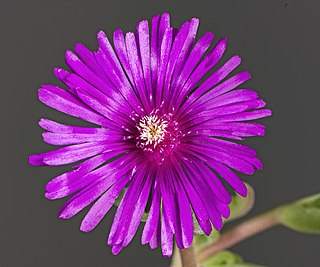
Lithops is a genus of succulent plants in the ice plant family, Aizoaceae. Members of the genus are native to southern Africa. The name is derived from the Ancient Greek words λίθος 'stone' and ὄψ 'face', referring to the stone-like appearance of the plants. They avoid being eaten by blending in with surrounding rocks and are often known as pebble plants or living stones. Lithops is both the genus name and the common name. The formation of the name from the Ancient Greek -ops means that even a single plant is called a Lithops.

Lampranthus is a genus of succulent plants in the family Aizoaceae, indigenous to southern Africa.

Delosperma is a genus of around 170 species of succulent plants, formerly included in Mesembryanthemum in the family Aizoaceae. It was defined by English botanist N. E. Brown in 1925. The genus is common in southern and eastern Africa, with a few species in Madagascar, Reunion island, Yemen and Saudi Arabia. Delosperma species, as do most Aizoaceae, have hygrochastic capsules, opening and closing as they wet and dry.

Antimima is a succulent plant genus in the family Aizoaceae, indigenous to South Africa and Namibia.

Glottiphyllum longum is a species of succulent plant in the family Aizoaceae, native to the Western Cape and Eastern Cape Provinces, South Africa.

Lithops viridis is a species of plant in the family Aizoaceae.

Glottiphyllum depressum is a common species of succulent plant, of the family Aizoaceae, native to South Africa.

Glottiphyllum oligocarpum is a species of succulent plant, in the family Aizoaceae. It is indigenous to arid areas of the Little Karoo, in the Western Cape, South Africa.

Glottiphyllum fergusoniae is a species of succulent plant, of the family Aizoaceae. It is indigenous to the western part of the Little Karoo, in the Western Cape, South Africa.

Glottiphyllum nelii is a species of succulent plant, in the family Aizoaceae. It is indigenous to the arid Great Karoo region, South Africa.

Acrodon is a genus of ice plants from South Africa. It comprises five species, mostly endangered and all restricted to the southern Cape regions of the Western Cape and Eastern Cape Provinces, South Africa.

Trichodiadema marlothii is succulent plant of the genus Trichodiadema, native to the Western Cape Province, South Africa, where it is known from the Robertson and Swellendam areas.

Trichodiadema mirabile is succulent plant of the genus Trichodiadema, native to the Western Cape Province, South Africa, where it is known from the Laingsburg area and especially from south-facing slopes.
Trichodiadema burgeri is succulent plant of the genus Trichodiadema, native to the Western Cape Province, South Africa, where it is known from the Ladismith and Oudtshoorn regions, extending southwards towards Mossel Bay.

Trichodiadema densum is a succulent flowering plant in the fig-marigold family Aizoaceae, native to the Willowmore region of the Western Cape Province, South Africa.
Trichodiadema attonsum is succulent plant of the genus Trichodiadema, native to the Western Cape Province, South Africa, where it is common among pale quartzite rocks in the western Little Karoo region. Unlike most other species in its genus, it does not have a typical diadem on its leaf-tips.
Ruschia leptocalyx is a species of succulent plant in the family Aizoaceae. It is endemic to the Cape Provinces of South Africa, where its natural habitat is in rocky renosterveld vegetation in the southern Cape.
Acrodon deminutus, also known as the Malgas tiptoothfig, is a species of mesemb from South Africa.
Acrodon caespitosus, the Potberg tiptoothfig, is a species of mesemb from South Africa.
Acrodon parvifolius, the Botriver tiptoothfig, is a species of mesemb from South Africa. This species, which grows close to the ground, can best be recognised by its small, thin leaves and its flowers, which form a dome in the middle.





















